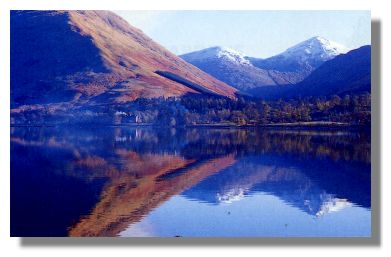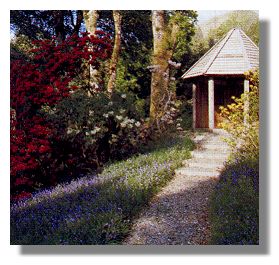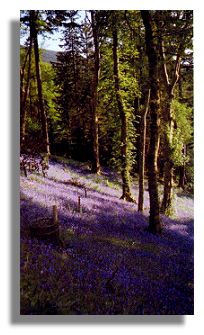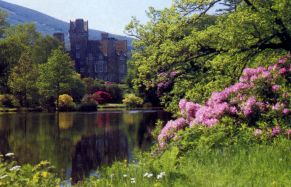
Introduction
In the dramatic Highland splendour of Glen Kinglas at the head of Loch Fyne in Argyll, stands Ardkinglas, an Edwardian mansion which must have been one of the most delightful homes in Scotland. The elegant creamy granite house, designed by Sir Robert Lorimer, is at the heart of a 15,000 acre estate which boasts one of the most magnificent woodland gardens in Britain.
This feature and illustrations first appeared in the Scots Heritage Magazine and was written by the editor, Susan Cromarty. My thanks to Susan for permission to create this Web version.
History
In 1906, when Sir Andrew Noble commissioned Scotland's favourite architect, Robert Lorimer, to design Ardkinglas, the building brief was short and to the point. "Nothing but the best and hang the expense!" Lorimer was told. Oh, and one other thing, "get on with it!" Sir Andrew, the chairman of Armstrong's, the armament company, was then in his mid- seventies and time was of the essence. Lorimer was given complete freedom to design the entire house down to the most minute detail. He and his team of superb Scottish craftsmen who were pretty much left on their own, did a magnificent job and had the whole place finished within just 18 months. Sir Andrew, an expatriate Scot who was then happily based south of the border in Northumberland, never intended Ardkinglas to be anything other than a Highland shooting lodge. But Sir Andrew's Scots Canadian wife, Margery, was a Campbell, and since Ardkinglas was very much in Campbell country, just across Loch Fyne from Inveraray Castle (seat of the Chief of Clan Campbell, the Duke of Argyll), it was she and the Nobles' energetic spinster daughter, Lilias ('Lily') who were determined to make it their permanent home. Naturally, the women had their way.
In 1369, Sir Colin Campbell, the then Mac Calien Mor, granted the estate to a younger son, Caileen Oig, "in all its righteous heaths and marches, or as long as woods shall grow and waters flow". The old Campbell castle at Ardkinglas was recorded as undergoing repairs in 1586 and by 1792 when Sir John Sinclair wrote his Statistical Account of Scotland, it had been razed for over 20 years. The Georgian house that replaced it was already half derelict by the time Dorothy Wordsworth, the poet's sister, arrived in 1822 to wander through the estate and admire the ancient woods which now boast some of the finest conifer specimens in Britain, as well as an outstanding collection of rhododendrons. It was the 25 acre woodland garden that I had especially come to Argyll to see.
The Garden Takes Shape
 The Ardkinglas site exploits a combination of high annual rainfall (80-100 inches) and Gulf Stream mildness to provide a unique growing environment. The fertile sandy loam prevalent throughout the garden contributes further to ensure conditions suitable for both ericaceous and temperate conifer species.
The Ardkinglas site exploits a combination of high annual rainfall (80-100 inches) and Gulf Stream mildness to provide a unique growing environment. The fertile sandy loam prevalent throughout the garden contributes further to ensure conditions suitable for both ericaceous and temperate conifer species.
The Calender family established the mature conifer collection, for which the garden is renowned, around 1875. The Victorian legacy ensures that Ardkinglas Woodland Garden now has no less than seven Champion trees (amongst the tallest or broadest of their species within the United Kingdom). It was Sir Andrew Noble's son, Sir John, who established the outstanding collection of rhododendrons in 1920. Encouraged by his early success and with the aid of his son, Michael (later Lord Glenkinglas), he set about planting a gift of rhododendrons from fellow enthusiast Lord Aberconway. Two railway carriages were dispatched from Bodnant, North Wales and sent to Arrochar station in 1935. These splendid mature specimens can now be seen in all their glory upon the aptly named Bodnant Bank. Lord Glenkinglas and his wife, Anne, continued to garden at Ardkinglas until the mid-1980s. Their influence is demonstrated throughout the woodland garden every March to mid~june with the flowering of the many hybrid rhododendrons that resulted from their extensive breeding programme.
Touring the Garden
 At the entrance to the garden the silver grey bark and broad spreading crowns of the Common Beech (Fagus sylvatica) provide a majestic welcome. These particular trees, along with several Common Oak (Quercus robur), are remnants from the late 18th century. Visitors are able to walk through the garden along a well defined footpath.
At the entrance to the garden the silver grey bark and broad spreading crowns of the Common Beech (Fagus sylvatica) provide a majestic welcome. These particular trees, along with several Common Oak (Quercus robur), are remnants from the late 18th century. Visitors are able to walk through the garden along a well defined footpath.
Beneath the footpath, the The Sorbus Glade, commenced in 1996, is beginning to provide colour and interest throughout the seasons. Included amongst the display are various species and cultivars such as S. decora, S. comixta, S. megalocarpa. Some of these plants have been grown from seed of wild origin. Just inside the garden, a number of trees have had lower branches removed to allow more daylight to reach the ground below and the area has been sensitively replanted with indigenous flora of northwest Europe including Blackthorn (Prunus spinosa), Guelder Rose (Viburnum opulus), Sweet Chestnut (Castanea sativa) and Common Hazel (Corylus avellana).
 Descending the trail the imposing landscape of the woodland garden unfolds with the unusual Tree of Heaven (Ailantus altissima). During 1999, a gazebo was constructed using Argyll-grown oak timber (see the picture above). The gazebo provides shelter and an opportunity to rest and enjoy the spectacular view of the garden looking across Loch Fyne towards Dunderave castle. Within the gazebo is the Scriptorium which contains various quotations from poetry and pose. Lines which aren't there but ought to be, were written by Rudyard Kipling: "and such gardens are not made, By singing: 'Oh, how beautiful,' and sitting in the shade".
Descending the trail the imposing landscape of the woodland garden unfolds with the unusual Tree of Heaven (Ailantus altissima). During 1999, a gazebo was constructed using Argyll-grown oak timber (see the picture above). The gazebo provides shelter and an opportunity to rest and enjoy the spectacular view of the garden looking across Loch Fyne towards Dunderave castle. Within the gazebo is the Scriptorium which contains various quotations from poetry and pose. Lines which aren't there but ought to be, were written by Rudyard Kipling: "and such gardens are not made, By singing: 'Oh, how beautiful,' and sitting in the shade".
The rhododendron collection is beautifully displayed on Bodnant Bank with the persistently deep fawn or rust-red indumented Rh. Roxieanum providing an attractive feature near the footpath. Beyond the Bodnant Bank a new planting of deciduous species provides an opportunity to increase diversity and seasonality. An added bonus for late spring/early autumn visitors is the extensive carpet of naturalised Bluebells (Endymion non-scriptus).
The trail meanders past a steep flight of stairs to reveal the open nature of the Mossy Wood. This is where visitors are most likely to catch a glimpse of the elusive Red Squirrel (Scitirus vulgaris).
Record Breaking Trees

The trail descends across a timber bridge and leads to the lower woodland garden. Located amongst an impressive display of mature rhododendrons are five Champion conifers including a Grand Fir (Abies grandis) which was measured at 202ft: in 1998.
Other Champions to be found here include the Western Red Cedar or Giant Arbor-Vitae, Thuja plicata; the Golden Plumed Sawara Cypress, Chamaecyparis pisfiera; the European Silver Fir, Abies alba; and the Patagonian Cypress, Fitzroya Cupressoides. It is well worth journeying to Ardkinglas just to see these magnificent trees. The Western Red Cedar, planted in 1875 stands at 47 metres. The Golden Plumed Sawara Cypress, planted in 1875 stands at 20.25 m. The European Silver Fir, planted in 1750 stands at 48.5 m and has a girth of 952 cm. The Patagonian Cypress, planted in 1870 stands at 22 metres.
The path ascends through a recently established collection of deciduous shrubs and emerges again into the Bodnant Bank to reveal a spectacular view across the lower woodland garden. The trail continues through to Sir John's Bank which contains the oldest collection of rhododendrons within the garden. Here are the particularly beautiful 'Loder's White', Rh.souliei and Rh. Maximum. Toward the end of the garden are several older rhododendrons along with a recently established collection of plants originating predominantly in North America including the early flowering Oso Berry (Oemleria cerasftormis) introduced from California in 1848. The trail finishes with a cosmopolitan arrangement of flowering trees and shrubs, notably the Sweet Pepper Bush (Clethra alnifolia), and Creeping Californian Lilac (Ceonothus thyrsiflorus Repens).
Ardkinglas Woodland Garden, Cairndow, Argyll, is open during daylight hours all year.



